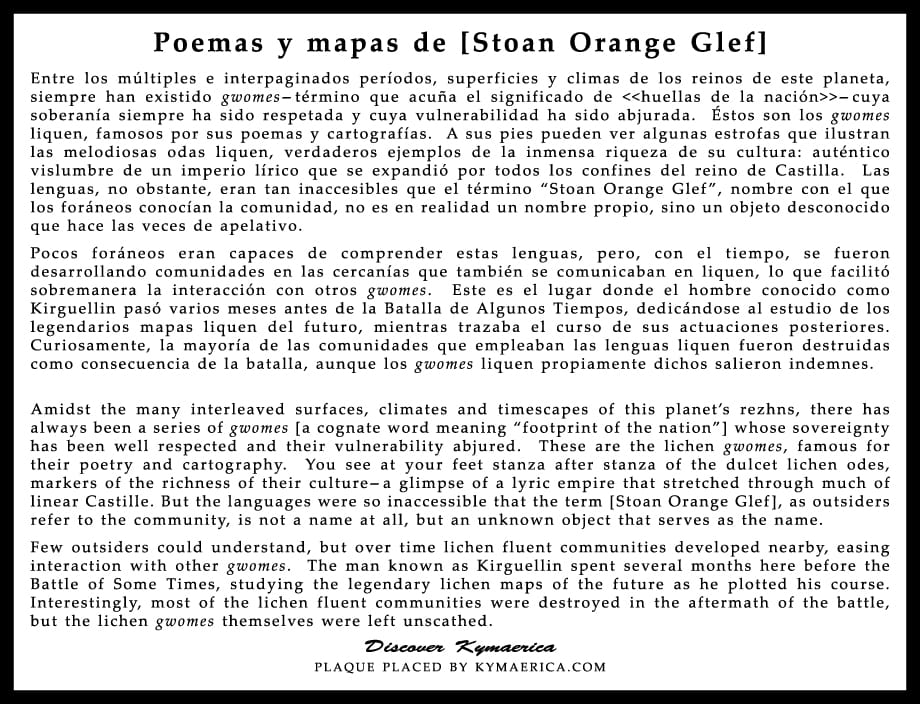Overview
[Stoan Orange Glef] is not technically the name of this gwome (a cognate word meaning “footprint of the nation”), it is the best approximation we can use because the actual name is “written” in the lichen tongue (if you will pardon the expression).
The installation here honors one of the most important of many lichen gwomes on the planet. The lichen language was impenetrable to most people, but some small communities (hongsedaunt) of interpreters–or partial interpreters–grew up around the lichen gwomes because within their poetry and maps was real wisdom. Sadly, many were destroyed in the chaos following the Battle of Some Times, setting back linguistic understanding for generations.
Access
Please visit at reasonable hours–not too late, not too early. It is a small village, and you will likely park in the center, behind the church. Then walk up the slope (bearing a little to the right, but always walking up hill) until you are out of the village–on the uphill side. Look around there.
Public Dedication
The installation of the marker in the near dark was celebrated with enthusiasm by the Unidad Valverde and the Geographer-at-Large!
This was Kcymaerxthaere installation #39, and the second in linear Spain.
Not in a Lichen Tongue, but in Two of Ours: English . . .
The part of the story installed here:
POEMAS Y MAPAS DE [STOAN ORANGE GLEF]
Amidst the many interleaved surfaces, climates and timescapes of this planet’s rezhns, there has always been a series of gwomes [a cognate word meaning “footprint of the nation”] whose sovereignty has been well respected and their vulnerability abjured. These are the lichen gwomes, famous for their poetry and cartography. You see at your feet stanza after stanza of the dulcet lichen odes, markers of the richness of their culture—a glimpse of a lyric empire that stretched through much of linear Castille. But the languages were so inaccessible that the term [Stoan Orange Glef], as outsiders refer to the community, is not a name at all, but an unknown object that serves as the name.
Few outsiders could understand, but over time lichen fluent communities developed nearby, easing interaction with other The Battle of Some Times 13 400 gwomes. The man known as Kirguellin spent several months here before the Battle of Some Times, studying the legendary lichen maps of the future as he plotted his course. Interestingly, most of the lichen fluent communities were destroyed in the aftermath of the battle, but the lichen gwomes themselves were left unscathed.
. . . and Spanish
POEMAS Y MAPAS DE [STOAN ORANGE GLEF]
Entre los múltiples e interpaginados períodos, superficies y climas de los reinos de este planeta, siempre han existido gwomes—término que acuña el significado de «huellas de la nación»—cuya soberanía siempre ha sido respetada y cuya vulnerabilidad ha sido abjurada. Éstos son los gwomes liquen, famosos por sus poemas y cartografías. A sus pies pueden ver algunas estrofas que ilustran las melodiosas odas liquen, verdaderos ejemplos de la inmensa riqueza de su cultura: auténtico vislumbre de un imperio lírico que se expandió por todos los confinesdel reino de Castilla. Las lenguas, no obstante, eran tan inaccesibles que el término “StoanOrange Glef”, nombre con el que los foráneos conocían la comunidad, no es en realidad un nombre propio, sino un objeto desconocido que hace las veces de apelativo.
Pocos foráneos eran capaces de comprender estas lenguas, pero, con el tiempo, se fueron desarrollando comunidades en las cercanías que también se comunicaban en liquen, lo que facilitó sobremanera la interacción con otros gwomes. Este es el lugar donde el hombre conocido como Kirguellin pasó varios meses antes de la Batalla de Algunos Tiempos, dedicándose al estudio de los legendarios mapas liquen del futuro, mientras trazaba el curso de sus actuaciones posteriores. Curiosamente, la mayoría de las comunidades que empleaban las lenguas liquen fueron destruidas como consecuencia de la batalla, aunque los gwomes liquen propiamente dichos salieron indemnes.

Gallery
Related Stories
Mlates gi Dunhuira
- Angel Alley and Surrounds
- The Gathering at the Llareggub
- The Unsoiling of Rockall
- The Lovers Touch
- Eine gefährliche Uberfahrt (A Dangerous Crossing)
- Poemas y Mapas de [Stoan Orange Glef]
- La Plaza de la Luna
- Place of Refuge
- Savior of a Friend
- The Way to the Moon (Paglalagay ng Mensahe sa Buwan)
- Lockstep (Sabay na paghakbang)
- Cave without Walls (无壁之穴)
- The Next Step (次の道程)
Nobunaga-Ventreven
- A Swath Like Stars
- A Swath of Stars
- The Lovers Touch
- Eine gefährliche Uberfahrt (A Dangerous Crossing)
- Poemas y Mapas de [Stoan Orange Glef]
- La Plaza de la Luna
- Lost in Scale (Tersesat dalam Skala)
- Place of Refuge
- Before the March
- Savior of a Friend
- Lockstep (Sabay na paghakbang)
- Cave without Walls (无壁之穴)
- The Next Step (次の道程)
Kirguellin
- A Swath of Stars
- Simultaneous Geographies
- Relearning Love
- Poemas y Mapas de [Stoan Orange Glef]
- Before the March







